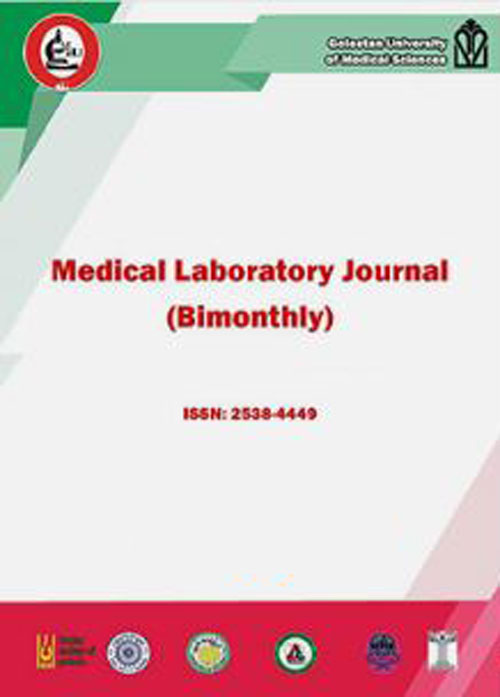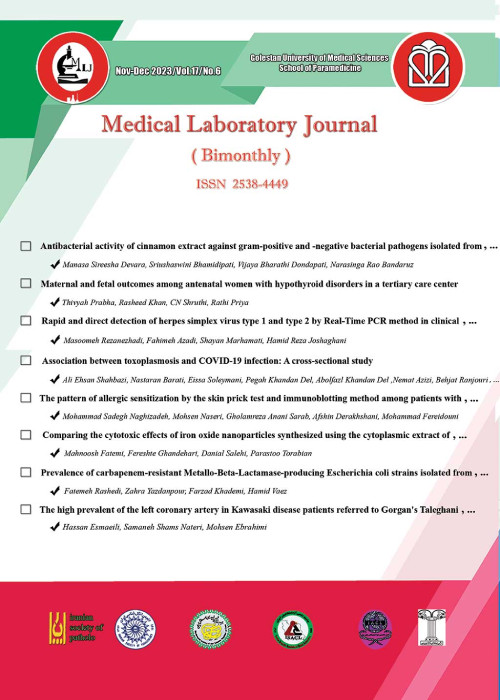فهرست مطالب

Medical Laboratory Journal
Volume:16 Issue: 3, May-Jun 2022
- تاریخ انتشار: 1401/03/11
- تعداد عناوین: 8
-
-
Pages 1-6Background and objectives
Soft tissue is a non-epithelial extraskeletal tissue of the body. Soft tissue tumors (STTs) are the most commonly diagnosed neoplasms. Fine needle aspiration cytology (FNAC) is minimally invasive, quick, and a definitive diagnostic modality. Biopsy for histopathology is the gold standard method for diagnosis but is invasive. The aims of this study were to determine the utility of FNAC in the diagnosis of STTs and correlate it with histopathology and to evaluate factors that cause discrepancies between FNAC and histopathology.
MethodsThis retrospective, record-based study was done on STTs received for FNAC and histopathology examinations at the Department of Pathology, MIMS, Mandya from January 2018 to June 2021.
ResultsA total of 74 cases of FNAC with histopathological correlation were available. Seventy one cases (95.9%) were benign and three (4%) were malignant according to FNAC. Discordance was seen in one case of low grade myxofibrosarcoma, which was diagnosed as benign spindle cell tumor on FNAC. The sensitivity, specificity, positive predictive value, and accuracy of FNAC in diagnosing malignancy were 75%, 100%, 100%, and 98.6%, respectively.
ConclusionOur findings indicate that FNAC is beneficial preoperatively as it differentiates between benign and malignant lesions in most cases. In the case of low grade myxofibrosarcoma, bland tumor cells led to a benign diagnosis on FNAC, but histopathology allowed sampling of a larger area of the tumor and the right diagnosis was made. Biopsy is the gold standard, but FNAC has high specificity in diagnosing malignant tumors and prevents unnecessary extensive, radical surgery for benign lesions.
Keywords: Biopsy, Fine-Needle, Soft Tissue Neoplasms -
Pages 7-13Background and objectives
Non-alcoholic fatty liver disease (NAFLD) is a chronic liver disease caused by the accumulation of large amounts of fat in the hepatocytes. Given that atorvastatin is effective for treatment of NAFLD, the present study investigated effects of high-fat/fructose diet (HFFD) with atorvastatin on liver enzymes and lipid profile in a NAFLD rat model.
MethodsThirty-two male Wistar rats were divided into four groups: 1) normal control, 2) HFFD control, 3) HFFD + atorvastatin, and 4) normal + atorvastatin. The groups received HFFD for 15 weeks to induce hepatosteatosis. Atorvastatin was administrated at the dose of 10 mg/kg/day. Lipid profile and liver enzymes were measured after eight weeks of intervention.
ResultsTriglyceride, cholesterol, gamma-glutamyl transferase, and aspartate transaminase were significantly reduced in the HFFD + atorvastatin group compared with the HFFD control group. In addition, cholesterol, high-density lipoprotein, alkaline phosphatase, and gamma-glutamyl transferase were significantly increased in the normal + atorvastatin group compared with the normal control group. Low-density lipoprotein increased significantly in the HFFD + atorvastatin group and the normal + atorvastatin group compared with other groups. There was a significant difference in the alanine transaminase levels between the groups taking atorvastatin. In fact, alanine transaminase level was lowest in the normal + atorvastatin group.
ConclusionAtorvastatin improves the lipid profile and fatty liver and controls liver enzymes. Therefore, it can be used with caution to improve the lipid profile and reduce the complications of NAFLD.
Keywords: Atorvastatin, Diet, High-Fat, Non-alcoholic Fatty Liver Disease -
Pages 14-18Background and objectives
Bacteriocins are generally active antimicrobial peptides effective against bacteria closely related to the producer. Escherichia coli produce two bacteriocins: colicins and microcins. Microcin J25 (Mcc J25) is an antibacterial peptide that inhibits bacterial transcription by disrupting the nucleotide-uptake channel of bacterial RNA polymerase. The objective of this study was to evaluate antimicrobial activity of MccJ25 produced by the bacteriocinogenic E. coli.
MethodsIn this experimental study, 120 clinical specimens were selected from private diagnostic laboratories in Isfahan (Iran) in 2020. Antagonistic activity of isolates was tested by adopting agar plug method. Total DNA was extracted from clinical specimens and polymerase chain reaction (PCR) was performed using specific primers for amplification of the complete sequence of MccJ25 gene. Accuracy of the PCR products was confirmed by direct sequencing. Homology analysis was performed by using BLAST. Data were analyzed with Chromasv2.1.1 software.
ResultsOverall, 120 E. coli strains were isolated from the clinical specimens. The antibiotic activity of Mcc J25 was mainly directed at Enterobacteriaceae, including several pathogenic E. coli strains of which 25 had positive well test samples, and about 5 (20%) of the collected clinical samples that were infected with E. coli had the MccJ25 gene.
ConclusionsBased on the results, Mcc J25 has favorable antibacterial potential, which can be further exploited as an alternative to chemical antibiotics.
Keywords: Bacteriocins, Microcin, Escherichia coli -
Pages 19-23Background and objectives
Sedentary life style and high-fat diet are one of the key causes of coronary artery disease. The aim of this study was to evaluate effects of periodic exercise and consumption of fenugreek seed extract on the expression of oxidized low-density lipoprotein (oxLDL) and reactive oxygen species (ROS) genes in patients with coronary artery occlusion.
MethodsThe present quasi-experimental study was performed on 32 men (60±5 years) with coronary artery disease. The subjects were randomly divided into four groups: control, exercise, fenugreek supplementation, and combination of exercise and fenugreek supplementation. The training program consisted of eight weeks of intermittent running at 55 to 65% heart rate reserve, three sessions per week, with an emphasis on gradual overload. The subjects consumed 10 mg/kg of body weight fenugreek extract daily. Data analysis was performed using two-way analysis of variance and Tukey's test at statistical significance of 0.05.
ResultsThe mean expression ratio of oxLDL and ROS genes in the intervention groups decreased significantly (p<0.0001). Compared with the control group, the most profound decreased in oxLDL and ROS expression occurred after combination of exercise and fenugreek supplementation (p<0.0001).
ConclusionThe results showed that intermittent exercise and consumption of fenugreek seed extract might have beneficial effects on the antioxidant defense system in patients with coronary artery occlusion.
Keywords: Exercise, Fenugreek Seed, Oxidised LDL -
Pages 24-29Background and objectives
Cutaneous leishmaniasis is endemic in most areas of Iran, and the diagnosis of its species is essential for controlling the disease. Leishmania major is the causative agent for cutaneous leishmaniasis in humans. Molecular methods are generally more sensitive than microscopic methods. The present study aimed to use a polymerase chain reaction-enzyme linked immunosorbent assay (PCR-ELISA) technique for detecting live L. major from wounds of patients with cutaneous leishmaniasis.
MethodsIn the present study, a standard strain of L. major promastigotes was used as the positive control for purification of DNA. The Novy–MacNeal–Nicolle and RPMI-1640 media were used for reproduction of parasites. DNA was isolated from specimens taken from 35 patients with suspected cutaneous leishmaniasis whose disease was confirmed by direct smear method. The PCR-ELISA technique was later applied by using the standard strain, patient specimens, and primers specific for the 18s rRNA.
ResultsOut of 35 patients, 17 (48.6%) were male and 18 (51.4%) were female. In addition, 8.6% of the patients lived in the Gonbad-e Kavus County, while all patients had been infected in villages around Gonbad-e Kavus. Of 35 patients with confirmed cutaneous leishmaniasis according to the direct smear method, 31 patients (86.31%) had leishmaniasis based on the PCR method and the PCR-ELISA methods.
ConclusionBased on the results, the PCR-ELISA method is more sensitive and accurate for detecting L. major.
Keywords: Leishmania major, PCR-ELISA, Patients -
Pages 30-35Background and objectives
The role of genetic components in expression of proteins involved in signaling pathways of fat and carbohydrate metabolism has been well-demonstrated. The aim of this study was to determine effects of high intensity interval training (HIIT) on glucose, insulin, and insulin resistance levels as well as IRS1 expression in gastrocnemius muscle of obese Wistar rats.
MethodsThe study included 14 male, Wistar rats (aged 10 weeks) weighting 220 ± 20 g. Obesity was induced in all rats via exposure to a high-fat diet for six weeks. Then, the rats were randomly divided into a HIIT group (n=7) and a control group (n=7). The rats in the HIIT group performed treadmill running, five sessions a week, for eight weeks. Levels of fasting glucose, serum insulin, insulin resistance, and IRS1 expression in the gastrocnemius muscle of the rats were measured after the last training session. Data were analyzed by the independent t-test at statistical significance of 0.05.
ResultsThe HIIT intervention significantly decreased fasting glucose compared with the control group (p<0.0001). It also resulted in a significant decrease in serum insulin levels and insulin resistance compared with the control group (p<0.0001). Moreover, the HIIT training significantly increased IRS1 expression (p=0.030) in the gastrocnemius muscle of rats.
ConclusionBased on the available evidence, the increase in insulin function and the decrease in insulin resistance can be attributed to increased IRS1 expression in the gastrocnemius muscle following HIIT training.
Keywords: High intensity interval training, Obesity, muscles -
Pages 36-41Background and objectives
Increased oxidative stress and altered antioxidant levels play an essential role in the pathogenesis of diabetes mellitus. Menopause is associated with increased food intake, weight gain, metabolic disorders, and increased level of inflammatory and oxidative stress factors. This study evaluated effects of oleuropein extract on brain tissue and serum oxidative status in ovariectomized diabetic rats.
MethodsIn this study, 40 female Wistar rats weighing 250±20 grams were randomly divided into four groups: control, sham (surgery without ovariectomy), ovariectomy+diabetes, and ovariectomy+diabetes+oleuropein supplementation. Diabetes was induced by intraperitoneal injection of streptozotocin. The rats in the treatment group received 60 mg/kg of oleuropein for 30 days by oral gavage. Finally, blood glucose, superoxide dismutase, glutathione peroxidase, total antioxidant capacity, and malonaldehyde levels were evaluated in serum and brain tissue samples.
ResultsWeight, blood glucose level, and antioxidant enzymes activity increased significantly in the ovariectomy+diabetes group compared to the control group.
ConclusionThis study suggested that the administration of oleuropein extract has beneficial effects on blood glucose level and antioxidant status in serum and brain tissue of ovariectomized diabetic rats.
Keywords: Oleuropein, Diabetes Mellitus, Antioxidants -
Pages 42-47Background and objectives
Intraoperative blood transfusion is a common medical intervention worldwide. Although mostly lifesaving when indicated, inappropriate administration of intraoperative can be potentially life-threatening. The aim of this study was to analyze the most common surgery/invasive procedures requiring intraoperative transfusion and to determine indications for intraoperative transfusion as well as the outcome of the patients after intraoperative transfusion.
MethodsA retrospective review of the electronic database of medical records was done for surgical patients who received intraoperative transfusion from June 2019 to December 2019. Preoperative hemoglobin values, associated comorbidities, and physiological triggers including hypotension and tachycardia were recorded. Descriptive statistics were used to summarize the data.
ResultsA total of 36 patients (age range: 9-80 years) were studied. Orthopedic surgeries (53%) were the most common surgeries that required intraoperative transfusion. Preoperative anemia (hemoglobin <10 g/dl) was the predominant reason for intraoperative transfusion. Type 2 diabetes mellitus (36.3%) was the most frequent comorbidity among the cases of intraoperative transfusion. Half the cases received two units of packed red blood cell (pRBC), while 39% of the cases received one unit of pRBC. The remaining 11.1% received more than two units of pRBC. Furthermore, 77.7% of the patients were discharged to home within a week, while 16.6% of the patients were discharged after a prolonged hospital stay (> one week). The remaining 5.5% died in the hospital within a week of the procedure/surgery.
ConclusionTransfusion practices vary among physicians, hospitals, and countries. The findings highlight that the hospital might be the most important determinant of the number of administered transfusions, with some adopting programs to reduce transfusions for elective surgery.
Keywords: Erythrocytes, General Surgery, Blood Transfusion


